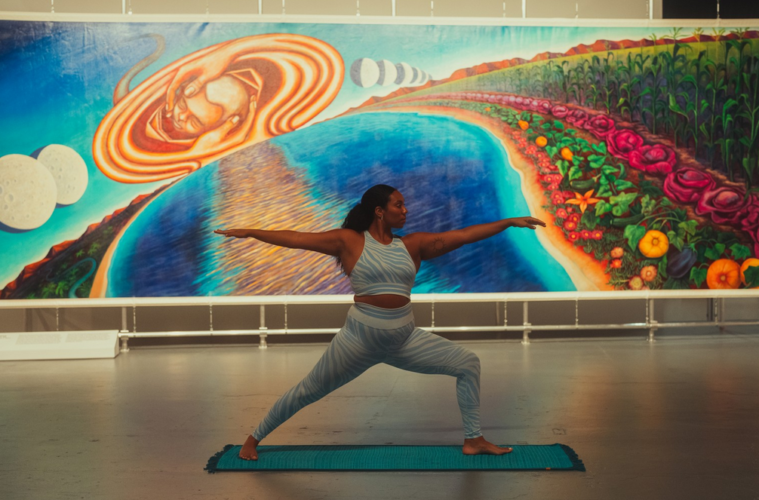Wellness, mindfulness, self-care — increasingly, art galleries and museums are the sites of well-being programs, from guided meditations to yoga classes, soundbaths, quiet mornings, and other consciousness-engaging curated experiences. Often, these events are intentionally located in the presence of specific works of art or exhibition installations that highlight the desired energy of the practice; in a pandemic holdover that’s proved successful for accessibility, some of it is also available online in both live-streamed and archived form. Nearly every institution in the area has enacted some form of this new dynamic — in an understandable pairing of art and thoughtful attention that has gained a lot of traction in the past few years for all the reasons.

New Abstracts, installation view (Courtesy of LACMA
CAAM has been hosting yoga and other self-care programs for years. MOCA, too, has been in this space for years, most recently hosting free hour-long yoga sessions for the past few months (the next one is an evening session on February 16), which are offered for all levels of expertise and body type, and led by longtime yoga instructor and community organizer Marley Rae. Presented facing the vibrant, expressive, ancestral, spiritual, and justice-oriented murals in the current Judith F. Baca: World Wall exhibition at the MOCA Geffen Little Tokyo location, the class itself is attuned to the message of community, resilience, and inclusive dialog — not to mention the high-vibration movement and palette — of the paintings. Along with its focus on physical strength, balance, quiet focus, and peacefulness in the psyche, and the urgency of taking better care of ourselves on an individual level, this inspired pairing of art and yoga also engages with a broader conversation around healing at the nexus of collective, systemic trauma, especially in communities of color.

Mindful Awareness Meditations at the Hammer
If you’re looking for a lighter touch, and even something you can do from home, the Hammer Museum and the UCLA Mindful Awareness Research Center have long been hosting free half-hour Mindful Awareness Meditation sessions every Thursday at 12:30pm, both live at the museum’s Billy Wilder Theater and streaming at their website. “Mindful awareness meditation is the moment-by-moment process of actively and openly observing one’s physical, mental, and emotional experiences,” promises the site, and these short weekly hits of quiet time can be just what the doctor ordered. Besides stress reduction, the satisfaction of reclaiming some time for yourself out of your workday is very real — whether at the site with some exhibition viewing thrown in after the reset, at your desk, or through your phone in the closest park.

Marley Freeman, ones former other one, 2021 (LACMA, Anonymous gift, © Marley Freeman, courtesy the artist and Karma)
LACMA has been in on this trend in a variety of ways as well — their regular Mindful Mondays 4pm zoom sessions continue on February 13 and March 13; their next guided Art & Meditation session happens inside the very on-topic Another World: The Transcendental Painting Group exhibition at 10am on Friday, January 27; and there’s an evening soundbath in that same lofty installation on March 21. But just last week the museum took a chance and tried something completely new — at least for them — offering a two-hour contemplation and craft-based session led by a trained art therapist.
Museotherapy, as this emerging field is known, is just what it sounds like — an outgrowth of the accelerating professional recognition of the mental (and physical) health benefits of art viewing, and an expansion of recognized techniques in art therapy applied to a more general audience. Mental Health and Well-Being in the Museum was led by Nicole Rademacher, an artist and art therapist whose practice centers around integrating the experience of viewing and later making art as a prompt and a source for a therapeutic experience — seeing things in new ways, and using your reaction to art as a springboard for digging deeper emotionally.

Naotaka Hiro: Untitled (Peaks), 2020 (Los Angeles County Museum of Art, purchased with funds provided by AHAN: Studio Forum, 2021 Art Here and Now, © Naotaka Hiro, courtesy of the artist and The Box)
“I believe it is important for our museums in Los Angeles to take into greater account how their collections and exhibitions can help their visitors through guided looking and meaningful reflection with the support of a mental health professional,” says Rademacher. “Especially now that we have a greater understanding of how the pandemic and other stressors have affected mental health.”
Well, there was only one way to find out, so off I went to therapy. The gathering was set up in the extremely suitable exhibition New Abstracts (which features selected recent acquisitions to the permanent collection with a focus on large-scale non-figurative mixed media painting). “Abstraction continues to offer rich possibilities for innovation and introspection,” reads the museum’s text. “Many artists working with abstract vocabularies today interrogate not only the possibilities of color, material, gesture, and form, but also the potential for injecting abstract art with political, spiritual, or personal meaning.” It was the ideal environment for the process of noticing, thinking, feeling, and wondering that followed.
Without oversharing my own experience or conveying the private thoughts of my fellow attendees, what happened was unique and impressive. Each person was asked to pick a piece that spoke to them, then spend about half an hour quietly contemplating it, taking stock of our emotional, intellectual, and physical responses. Does the work calm or excite us, cause memories to surface, generate energy in the breath or body as we sink into it? After the initial attraction, can we identify what it is about the work — color, shapes, materials — that’s provoking these responses? We were asked to pay attention to what came up for each of us, and to figure out why if we could. I fell in love with a Channing Hansen piece made of loosely knit yarn, its network of color, texture, seam, scar, translucence, and shadow is fascinating for how it behaves like a painting by another means — but also reminds me of my mother and her loom and needle textile art practice. It was a gorgeous game to follow its loops and lines. Later, in the art-making half of the night, I tried to draw it from memory to see if I really had been paying attention. I did alright.

Agnes Pelton, Winter, 1933, on view at LACMA (Courtesy of the Crocker Art Museum)
Honestly just having our phones off and spending an extended amount of time with a single work — 30 minutes instead of 90 seconds and without taking a single selfie — was already a balm for a busy soul. I’m someone who is accustomed to exploring art through language, in a public and history-facing discourse of exposition that is not — or is at least not only — emotive or cathartic. I realized that when it comes to art, the critic is in danger of doing everything by thinking; of seeing with the brain, of feeling through thought, of stepping straight into the professionalized interpretive mode and neglecting the place of wonder and love that set them — set me — on the path of art writing in the first place. Several of the other attendees mentioned that the experience “reminded them of being a kid again,” meaning a pure sense of discovery. I felt that, and it was a powerful reminder of what I am — what we are all — doing here: looking for something that moves us. Obviously any fully realized course of therapy will involve hard work and take time; but this small, safe introduction to the monumental role art can play in that process was a proper eye-opener — and for those of us in the museum that night, it was absolutely good medicine.

Art+Yoga with Marley Rae at MOCA (Photo by Kavi Peshawaria)
Editor’s note: The disclaimer below refers to advertising posts and does not apply to this or any other editorial stories.
Advertising disclosure: We may receive compensation for some of the links in our stories. Thank you for supporting LA Weekly and our advertisers.

